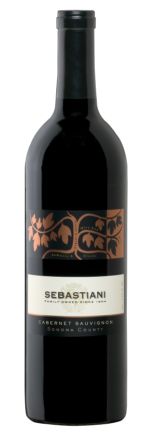 If you don’t have a wine cellar but want to start one, I have a one word solution for you: “Sebastiani”. This is the name of a family winery in California with a history going back to 1825. I had their 2005 Cabernet Sauvignon (
If you don’t have a wine cellar but want to start one, I have a one word solution for you: “Sebastiani”. This is the name of a family winery in California with a history going back to 1825. I had their 2005 Cabernet Sauvignon ($20.95 [Ed. note: 2005 no longer available], Vintages #640573) last Friday and it is the perfect wine to use as the foundation for a wine cellar. In fact, if all you have in your basement is a case of this wine, you will have something delightful to pull out two or three times a year for the next five years.
A couple weeks ago, I wrote about a Spanish wine that you can buy “pre-aged” in order to discover right now how maturation improves a wine. The Sebastiani is at the other end of the spectrum: it is a recent wine that is designed to be matured at home. While it tastes great now, it is crafted as a long term investment that will repay patience in dividends.
The Sebastiani costs $20, but it has the complexity, depth and aging potential of something much more expensive. I knew it was special simply from the nose: cocoa, rawhide, bracken and berries are well-delineated and vivid before you even take a sip. More impressive, however, is the body or “mouth feel” of this wine. It is thick, dense and packed with flavour, without being too alcoholic (13.5 percent is moderate for a California red) or too jammy and overcooked.
The capstone for the Sebastiani is its complexity. Many wines can achieve this depth of flavour, but few (at least at this price) are able to dignify their forcefulness with nuances and filigree. My palate was stippled with bursts of blackberries, plums, chocolate, and cinnamon. The complexity arises in part because the Cabernet Sauvignon is cut with a variety of other grapes – a so-called “Bordeaux blend”. The sum total is a wine with beauty and horsepower.
There is a downside. The Sebastiani is very tannic. Tannins are the tea-like flavours extracted from the skins, seeds, stems, and barrels involved in the winemaking process. Strong tannins are most apparent in young red wines, where they strangle the tongue and obscure the fruity flavours. In the case of the Sebastiani, the tannins were aggressive on the finish and marred it with bitterness.
This is where cellaring comes in. The mellowing of tannins is one of the first goals of aging wine. The Sebastiani’s underlying structure of bright acidity and robust tannins distinguishes it as an excellent candidate for this maturation in the bottle. You can drink it now, if you let it breathe for 90 minutes, but I am looking forward to rediscovering it in two, four, and five years. Will it live up to the promise of its precocious youth? There’s only one good way to find out.
Matthew Sullivan is a lawyer with the Department of Justice in Toronto. He writes a weekly blog entry here on lawandstyle.ca. The Short Cellar column appears in the print edition of Precedent. Matthew can be reached at matthew@lawandstyle.beta-site.ca

